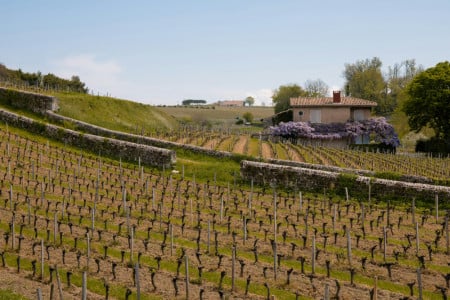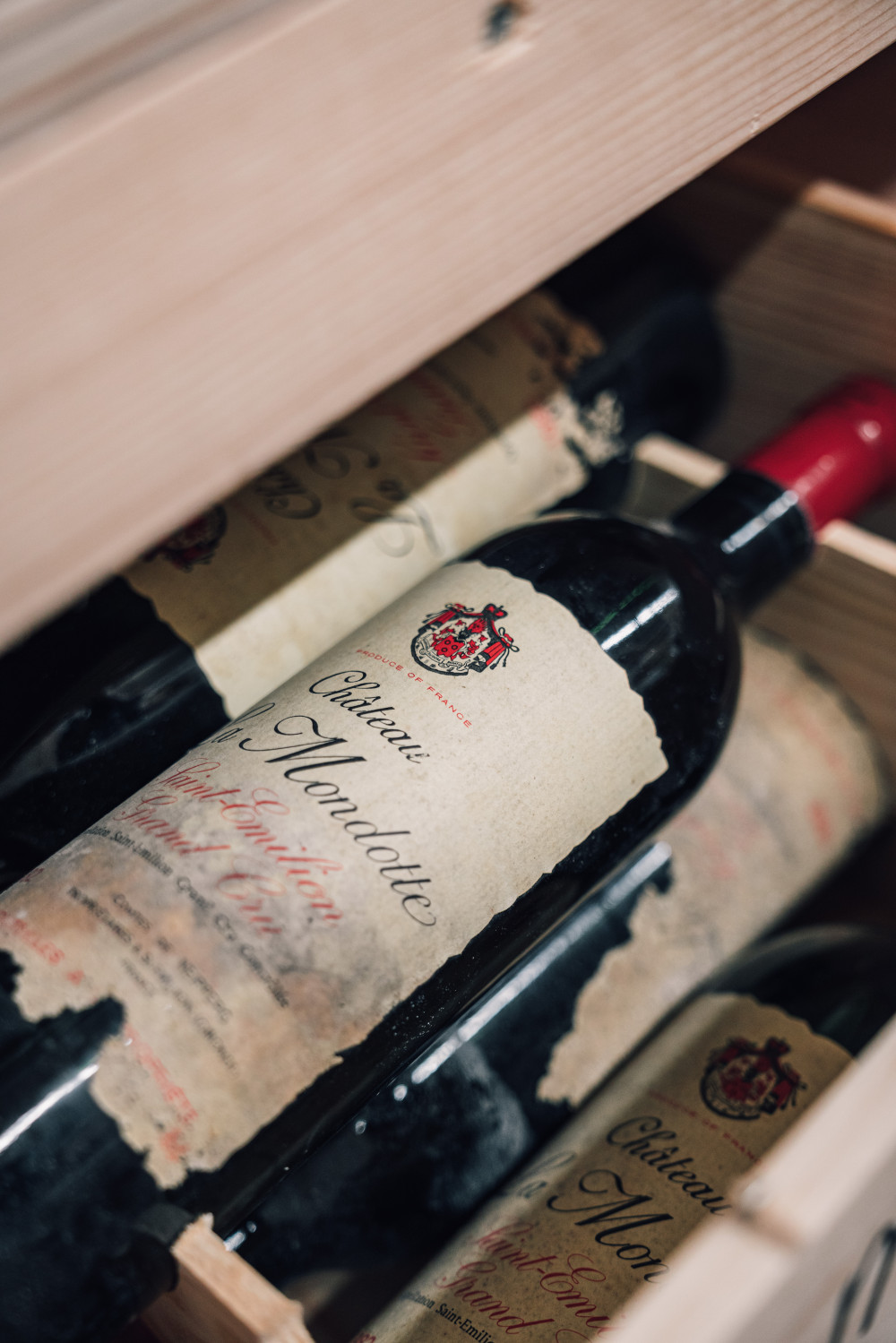Saint-Emilion
Saint-Emilion is located in Bordeaux's Libournais district, on the right bank of the Garonne River. Cheval Blanc, Angélus, Ausone, Pavie and Figeac – the list of châteaux in Saint-Émilion reads like a who's who of France's top Bordeaux wines and is therefor known for producing the highest-quality red wines.
The best wines from Saint-Emilion
Saint-Emilion is located in Bordeaux's Libournais district, on the right bank of the Garonne River. Cheval Blanc, Angélus, Ausone, Pavie and Figeac – the list of châteaux in Saint-Émilion reads like a who's who of France's top Bordeaux wines and is therefor known for producing the highest-quality red wines.
The wines consist mainly out of Merlot (79%), with smaller percentages of Cabernet Franc (15%) and Cabernet Sauvignon (6%). Saint-Emilion was officially recognised as an AOC in 1936, and the region is a UNESCO World Heritage Site.

Where exactly is the Saint-Émilion appellation located?
About 40 kilometers east of Bordeaux, the town of Saint-Émilion sits atop a plateau at the upper end of a valley basin, overlooking the Dordogne on the Right Bank. The vineyard area, covering approximately 5,500 hectares, surrounds the town and extends all the way to the riverbank, which forms the natural northern boundary. To the south, Saint-Émilion directly borders another prestigious Bordeaux appellation: Pomerol.
As early as the 3rd century, Roman legionaries planted the first vines here. The Gallo-Roman poet Ausonius, whose name inspired one of the most prestigious estates in the region (Château Ausone), was among the first winemakers in the area. However, he had no connection to the name of the appellation. The name Saint-Émilion derives from a wandering monk named Aemilianus, who lived here in the 8th century and was venerated by the local population. His followers built a church under a limestone cliff, which can still be visited today.
Saint-Émilion has its own classification system, which differs from those of other Bordeaux appellations. In addition to the general AOP categories (Appellation d’Origine Protégée), there are the communal appellations Saint-Émilion and Saint-Émilion Grand Cru. The classification is revised every ten years and is based on strict criteria, including sensory quality, reputation, market price, and terroir. Within this framework, there are further distinctions such as Saint-Émilion Grand Cru Classé and Premier Grand Cru Classé (A or B). However, some renowned estates, such as Ausone, Cheval Blanc, and Angélus. All formerly classified as Premier Grand Cru Classé A, have since opted out of the classification process.
Which grapes are grown in Saint-Émilion?
Although Saint-Émilion also produces white wines, the heart of the region clearly beats for red wines. Merlot is the absolute star here. This is mainly due to the soils, which we will look at in more detail in the next section. Merlot is usually accompanied by Cabernet Franc. There are also small plantings of Cabernet Sauvignon here and there, but this grape variety only thrives moderately on the soils of Saint-Émilion. On the Left Bank, this grape may be the big star, but on the Right Bank, it is more of a supporting actor. Sauvignon Blanc and Sémillion are also found here and there, forming the dynamic flavour duo for the white cuvées. However, the terroir of Saint-Émilion is actually much more important than the grape varieties, as it has a decisive influence on the taste of the wines.
Climate and soils in Saint-Émilion
The climate in Saint-Émilion is temperate maritime with warm summers and mild winters. The proximity to the Dordogne provides a further balancing effect, as the river stores heat during the hot months and releases it again in autumn, allowing the grapes to ripen undisturbed. This brings us finally to the soils, which are a mosaic of limestone, clay, sand and gravel, and which, in various combinations, create different micro-terroirs. These can be divided into three different areas.
The limestone plateau is the heart of the appellation and forms the backbone of the terroir. Here, the vines grow directly on the hard limestone rock after a thin layer of soil. This soil is particularly valuable because it can store water and make it available to the vines through capillary action, even during dry periods. The vines have to root deeply to find nutrients, which gives the wines a pronounced minerality. These soils are ideal for Merlot, as they promote its fruity and elegant characteristics.
The slopes of the plateau, also known as ‘coteaux’, offer the vines excellent sun exposure and promote early ripening of the grapes. The soils here consist of clayey and calcareous molasse, a soft rock that is easily penetrated by the roots. The clay in the subsoil ensures sufficient water supply in summer and prevents waterlogging during wet periods. These soils promote a good balance between fruit and structure in the wines.
Famous Saint-Emilion wine producers
Chateau Angelus, Chateau Ausone, Chateau Cheval Blanc, Chateau Figeac, Chateau Pavie, the list goes on and on. Below some other chateaux, check our stocklist for other available wines from Saint-Emillion.
Wine producers
What does a Saint-Émilion wine taste like?
As you might expect, the wines from Saint-Émilion cannot be lumped together due to the different terroirs. Or perhaps fortunately, as this allows you to enjoy a fascinating variety. The limestone plateau, for example, produces very mineral wines that are characterised by elegance and depth. The Coteaux produce fruity and structured wines with a good balance. The lighter wines, which are accessible early on, come from the sandy soils.
Nevertheless, there are a few similarities. A typical Saint-Émilion wine is dry, full-bodied and smooth. The aromas range from red berries such as cherries and currants to floral notes and delicate herbal spices. The best wines are characterised by a perfect balance between fruit, acidity and tannins. With increasing maturity, they develop complex nuances such as mocha or vanilla.
What food goes well with wines from Saint-Émilion?
A Saint-Émilion wine is generally somewhat finer and more delicate than its Pomerol counterpart. Although game dishes or steak also go well with these wines, we recommend rabbit, as the delicate meat flavours harmonise better. Paprika goulash is also an excellent choice, as are grilled vegetables. If you want to enjoy a mature Saint-Émilion, a porcini mushroom risotto is a perfect accompaniment, as it perfectly complements the tertiary aromas of the wine.
However, if you have a Premier Grand Cru Classé A or B in front of you, we have a completely different tip for you: enjoy it on its own and live in the moment. These are vinophile memories that you will never forget. We promise. Would you like to learn more about the wines from Saint-Émilion? Then let yourself be inspired by the large and sophisticated range at Best of Wines!
Other regions



